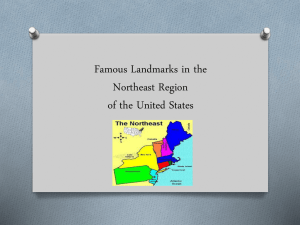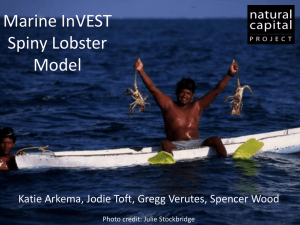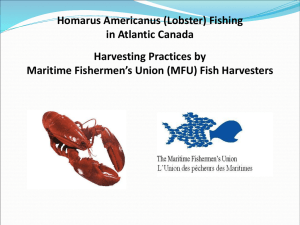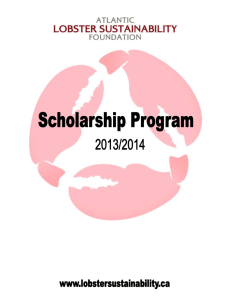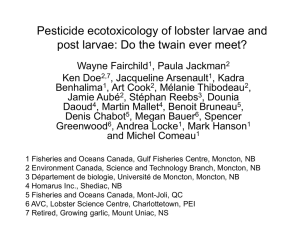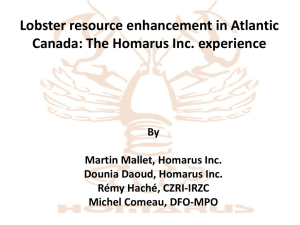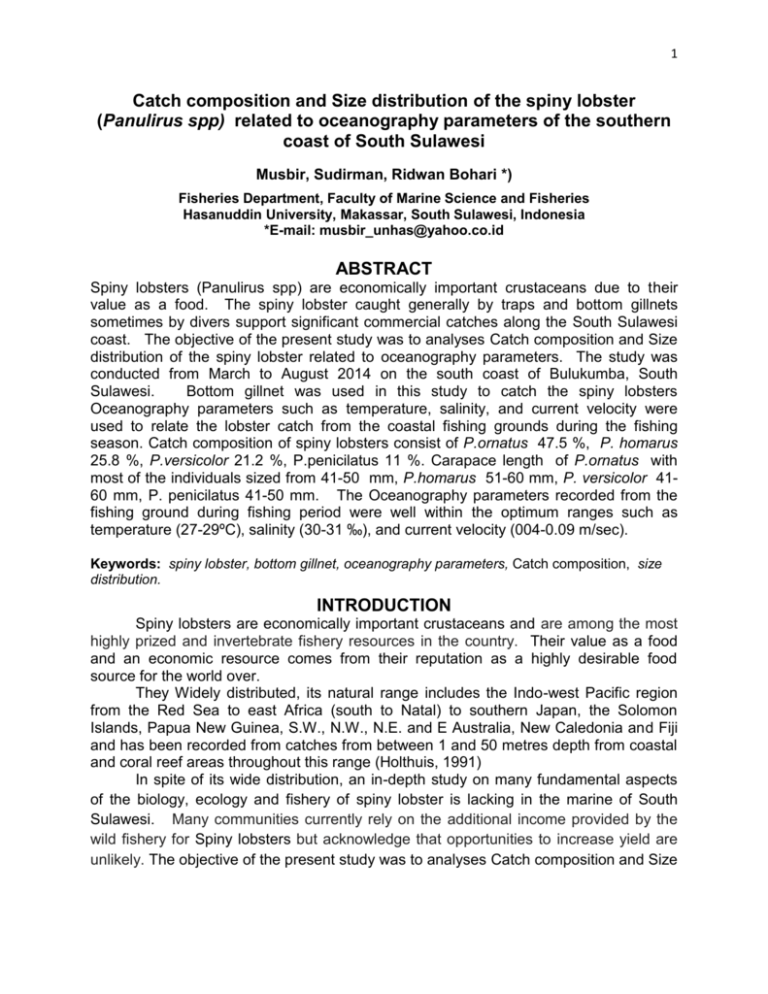
1
Catch composition and Size distribution of the spiny lobster
(Panulirus spp) related to oceanography parameters of the southern
coast of South Sulawesi
Musbir, Sudirman, Ridwan Bohari *)
Fisheries Department, Faculty of Marine Science and Fisheries
Hasanuddin University, Makassar, South Sulawesi, Indonesia
*E-mail: musbir_unhas@yahoo.co.id
ABSTRACT
Spiny lobsters (Panulirus spp) are economically important crustaceans due to their
value as a food. The spiny lobster caught generally by traps and bottom gillnets
sometimes by divers support significant commercial catches along the South Sulawesi
coast. The objective of the present study was to analyses Catch composition and Size
distribution of the spiny lobster related to oceanography parameters. The study was
conducted from March to August 2014 on the south coast of Bulukumba, South
Sulawesi.
Bottom gillnet was used in this study to catch the spiny lobsters
Oceanography parameters such as temperature, salinity, and current velocity were
used to relate the lobster catch from the coastal fishing grounds during the fishing
season. Catch composition of spiny lobsters consist of P.ornatus 47.5 %, P. homarus
25.8 %, P.versicolor 21.2 %, P.penicilatus 11 %. Carapace length of P.ornatus with
most of the individuals sized from 41-50 mm, P.homarus 51-60 mm, P. versicolor 4160 mm, P. penicilatus 41-50 mm. The Oceanography parameters recorded from the
fishing ground during fishing period were well within the optimum ranges such as
temperature (27-29ºC), salinity (30-31 ‰), and current velocity (004-0.09 m/sec).
Keywords: spiny lobster, bottom gillnet, oceanography parameters, Catch composition, size
distribution.
INTRODUCTION
Spiny lobsters are economically important crustaceans and are among the most
highly prized and invertebrate fishery resources in the country. Their value as a food
and an economic resource comes from their reputation as a highly desirable food
source for the world over.
They Widely distributed, its natural range includes the Indo-west Pacific region
from the Red Sea to east Africa (south to Natal) to southern Japan, the Solomon
Islands, Papua New Guinea, S.W., N.W., N.E. and E Australia, New Caledonia and Fiji
and has been recorded from catches from between 1 and 50 metres depth from coastal
and coral reef areas throughout this range (Holthuis, 1991)
In spite of its wide distribution, an in-depth study on many fundamental aspects
of the biology, ecology and fishery of spiny lobster is lacking in the marine of South
Sulawesi. Many communities currently rely on the additional income provided by the
wild fishery for Spiny lobsters but acknowledge that opportunities to increase yield are
unlikely. The objective of the present study was to analyses Catch composition and Size
2
distribution of the spiny lobster (Panulirus spp) related to oceanography parameters in
southern Bulukumba coast, South Sulawesi.
MATERIALS AND METHODS
The study was conducted from March to August 2014 on the south coast of Bulukumba,
South Sulawesi (Fig. 1).
The coast presents extensive sand beaches with some
gravel-sand patches, while large areas offshore are covered with gravel-sand. The
study area was substratum type with mostly a sand and rare rubble seabed. Algae were
often abundant particularly (Euchema spp.) were common.
Figure 1. Map of the study area in the south coast of Bulukumba, South Sulawesi,
Indonesia.
Spiny lobsters were captured in traps and bottom gill nets sometimes by divers in
the area. Mean while bottom gillnet was used in this study to catch the spiny lobsters.
They have stretched meshes size of 10 cm, lengths between 150 m and a height 1.5 m.
Tthe nets are left in the water for 24 h (one fishing day). Lobsters caught with bottom
gillnet nets from depths of approximately 0.5-10 m were sampled at random every
month from Marc to August 2014. The oceanography parameters including sea
temperature, salinity and current velocity of fishing grounds was measured in each
fishing operation.
The target species was determined according to the catalogues of Holthuis
(1991) Lobster was identified with color contour in body segment (Holthuis, 1991 and
Chan, 2000). The catch composition of all species was described Poole (1974) Bengen
(2000):
ni
P = ----- x 100 %
N
Where
P = Persentase one speices caught spiny lobster
ni = Total one speices caught spiny lobster
3
N = Total all species speices caught spiny lobster
Carapace length (CL) were measured along the mid dorsal line, from the transverse
ridge between the postorbital spines to the posterior edge of the carapace with a caliper
(± 0.1 mm).
RESULT AND DISCUSSION
Catch Composition
There are four species reported in this study including (P.ornatus, P.homarus,
P.versicolor, P.penicilaltus. (Fig. 1).
Catch Composition of Spiny Lobster (N=257)
4.3
16.0
44.4
P. ornatus
P. homarus
P. versicolor
P. penicilatus
35.4
Figure 2. Catch composition of spiny lobster (Panulirus spp) during fishing period in
south coastal of Bulukumba South Sulawesi.
A total of 257 spiny lobster were caught from March to July 2014,, of which 114
(44.4 %) belonged to the species P.ornatus, 91 (35.5 %) to P.homarus, 16 (21.2 %) to
P.versicolor and 11 (4.3 %) to P.penicilaltus. The observed relative proportions of
these lobster species showed an inversion during the study period. Individuals of
P.ornatus were the most frequently caught and following of P. homarus and
P.versicolor while P. penicillatus constituted the lowest frequently caught. So, P.
ornatus is the most important spiny lobster and P. homarus is the second most
important spiny lobster in the study area.
The fisheries-dependent data collected in this study are considered quite
representative of the wild population. Both P. ornatus and P. homarus are reef dwelling
species, most abundant on coral and coastal fringing rocky reefs and the areas
surrounding them. Both are less commonly found in inshore areas of a sedimentary
nature, indicating their broad environmental tolerances that make them suitable for
aquaculture. They are found in depths of 1 to 50 m. The juvenile and adult stages of
both species are omnivorous, grazing primarily on small crustaceans, molluscs, worms
and algae. They are generally nocturnal, most active from dusk through to dawn. Both
are highly social, preferring to congregate in groups in hollows, caves and crevices
within and beneath the reef structures.
4
Size distribution
The size of spiny lobster individuals ranged from 26 to 70 mm CL during study period.
(Fig.3, 4, 5, 6). with most of the individuals sized of P. ornatus from 26 to 50 mm CL
with most of the individuals sized 41-50 mm. The lobster P. homarus ranged from 21 to
70 mm CL of, with most of the individuals sized from 51 to 60 mm CL. The lobster P.
versicolor ranged from 21 to 60 mm CL of, with most of the individuals sized from 51 to
60 mm CL. The lobster P. penicilatus ranged from 21 to 50 mm CL of, with most of the
individuals sized from 41 to 50 mm CL.
N = 114
Number of P.
ornatus
40
30
20
10
0
21-30 mm 31-40 mm 41-50 mm 51-60 mm 61-70 mm
Carapace Length
Number of P. homarus
Figure 3. Size-frequency distributions of Panulirus ornatus by 10- mm-CL size classes
during study period in southern coast of South Sulawesi .
N = 91
40
30
20
10
0
21-30
mm
31-40
mm
41-50
mm
51-60
mm
61-70
mm
Carapace Length
Figure 4. Size-frequency distributions of Panulirus homarus
by 10- mm-CL size
classes during study period in southern coast of South Sulawesi .
5
Number of P.
versicolor
N = 41
30
20
10
0
21-30 mm
31-40 mm 41-50 mm
Carapace Length
51-60 mm
Figure 5. Size-frequency distributions of Panulirus versicolor
classes during study period in southern coast of South Sulawesi .
by 10- mm-CL size
Number of P.
penicilatus
N = 11
5
0
21-30 mm
31-40 mm
41-50 mm
Carapace Length
Figure 6. Size-frequency distributions of Panulirus penicilatus
classes during study period in southern coast of South Sulawesi.
by 10- mm-CL size
The fisheries-dependent data collected in this study are considered quite representative
of the wild population. This is indicated that the pattern of movement of lobsters along
the shore could be factors influencing the size composition of the catch. Although the
bottom gillnet indiscriminately target all lobsters using mesh size bottom nets due to
their high value regardless of size.
Oceanography Parameters
The oceanography parameters recorded from the fishing ground during the fishing
operation were presented in Figure 7, 8, 9.
Number Spiny
Lobster
60
40
20
0
27 o C 27.2 o C27.3 o C27.4 o C27.6 o C27.8 o C 28 o C
Sea Temperature
Figure 7. Number of spiny lobster relate to sea temperature during study period in
southern coast of South Sulawesi.
Number of Spiny Lobster
6
50
40
30
20
10
0
30 ppt 30.2
ppt
30.3 30.4 30.8 31 ppt 31.2
ppt Salinity
ppt
ppt
ppt
31.3
ppt
Number of Spiny
Lobster
Figure 8. Number of spiny lobster relate to salinity during study period in southern coast
of South Sulawesi.
60
40
20
0
Current Velocity
Figure 9. Number of spiny lobster caught relate to current velocity during study period
in southern coast of South Sulawesi.
The study shows water temperature ranged from 27 ºC to 28 ºC. The highest
catch was occurred in water temperature 27 ºC. Water temperature is an important
environmental factor enhancing growth and reproductive cycle of lobster (Ikhwanuddin
et al., 2016). Salinity ranged from 30-31.3 ppt. Salinity is one of the major factors that
may significant affect the physiology of aquatic organism, for example, a reduction in
salinity resulted in increased haemolymp total protein and haemocianin plasma level in
Homarus americanus (Jury et al., 1994) and similarly, lower salinity caused significant
increase in oxygen consumption in Penaeus japonicas (Noga, 2000).
The study show that current affect on number of spiny lobster caught. The
highest catch was occurred in current speed 0.05 msec-1. In contras, the lowest catch
was occurred in current speed 0.11 msec-1. Current velocity play role in fish catch
operation. It is necessary to pay attention to current velocity during fishing operation.
The fish abundance of Aluterus monoceros was affected by current
in which the
strongest current speed the lowest fish assemblage (Demster, 2005). Fish assemblage
around culture area decrease with increase current speed (Bergman et al., 2001).
7
The oceanography parameters recorded from the fishing ground during the
fishing operation were well within the optimum ranges for lobster. The optimal
oceanography parameters reported for lobster farming are: temperature (26-33ºC),
salinity (25-35‰), pH (6.8-8.5), (Philips et al., 1980; Van Olst et al., 1980; Kittaka,
1994).
ACKNOWLEDGEMENTS
The author thanks Ansar and Idris for their help in field sampling activities. Commercial
samples were obtained from catches of the fishermen in south coastal of Bulukumba
Regency, South Sulawesi. This project was supported by the Directorate General of
Higher Education, Republic of Indonesia.
REFERENCES
Bengen, D.G. 2000. Sinopsis Teknik Pengambilan Contoh dan Analisa Daya Biofisik
Sumberdaya Pesisir. PKSPL-IPB. Pp 87.
Bergman, K.S., S.Svenson, M.C.Ohman. 2001. Influence of algal farming on fish
assemblages. Marine Pollution Bulletine, 42 No.12: 1379-1389.
Chan, T.Y. 2000. Lobster. In the Living Marine Resources of the Western Central
Pacific. Volume 2 Cephalopods, crustaceans, holothurians and sharks. FAO
Species Identification Guide for Fishery Purposes. FAO-UN, Norwegian Agency
for International Development.
Demster, T. 2005. Temporal variability of pelagic fish assemblages around fish
aggregation devices: biological and physical influences. Journal of Fish Biology,
66: 1237-1260.
Holthuis, L.B. 1991. Marine lobster of the world. An annotated and illustrated catalogue
of species of interest to fisheries known to date. FAO Fish. Synop., 13(125): 1292.
Ikhwanuddin, M., Fatihah, S.N., Nurfaseha, A.H., Fathiah, M., Effendy, M., Shamsudin,
A, Siti Aishah, A., Abol Munafi, A.B., 2014. Effect of Temperature on Ovarian
Maturation Stages and Embryonic Development of Mud Spny Lobster, Panulirus
polyphagus. Asian Journal of Cell Biology 9(1) 1-13.
Jury, S.H., Kinnison, M.T., Howell, W.H., Watson, W.H. 1994. The effect of reduced
salnity on lebster (Homarus americanus Milne-Edwards) metabolism implications
for estuarine population. J. Exp. Mar. Biol. Ecol. 176 167-185).
Kittaka, J. 1994. Culture of phyllosomas of spiny lobster and its application to studies of
larval recruitment and aquaculture. Crustaceana, 66: 258-270.
Noga, E.J., Hemolymph biomareker of crustacean health. In Fingerman M.
Nagabhushanam R. editors Recent advances in marine biotechnology. New
Hampshire Science Publisher Inc p 124-163.
Phillips, E. S., Cobb, J. S. and George, R. W. 1980. General biology. In: Cobb, J. S. and
Phillips, E. S. (Eds.), The biology and management of lobster, Academic Press,
New York, 1: 1-82.
8
Poole, R.V. 1974. An Introduction to Quantitative Ecology. Mc.Graw Hill Series in
Population Biology. Inc. All Right Reserved. Printers in United States of Americ.
California. Pp 76.
Van Olst, J. C., Carlberg, J. M. and Hughes, J. T. 1980. Aquaculture. In : Cobb, J. S.
and Phillip, B. F. (Eds.), The biology and management of lobsters. Academic
Press, New York, 11: 333-384.


